Comparing and Verifying the Taste of Koshihikari Rice from Six Different Regions, and Examining its Compatibility with Water and Pot Cooking
Based on a taste database exceeding 120,000 items, Taste & Aroma Strategic Research Institute, a company that scientifically studies food (headquarters: Chuo-ku, Tokyo; President: Michihiro Koyanagi), conducted taste analysis using a “taste sensor” utilizing sensory engineering technology to analyze the taste of various mineral waters and the influence of water on dishes.
Taste & Aroma Strategic Research Institute utilizes taste big data and AI analysis technology from around the world to quantify the “taste” of food. As a next-generation food tech think tank company, they aim to express “taste” in an easily understandable manner.
In this study, attention was focused on “water,” which continued to grow in a beverage market that was said to be struggling during the COVID-19 pandemic. According to the trend in per capita consumption of mineral water announced by the Japan Mineral Water Association [Figure 1], the consumption of mineral water has increased approximately 2.5 times from 2005 to 2021. Consequently, the domestic production of mineral water [Figure 2] has also been increasing. In an era where many people buy water, what are the factors that determine its taste? An analysis and verification were conducted on how water affects the taste of tea and dashi.
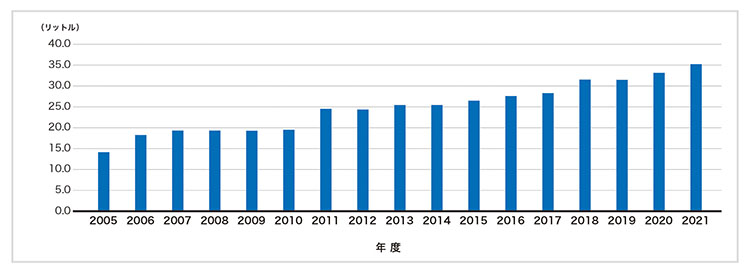
(Source: Japan Mineral Water Association statistical data)
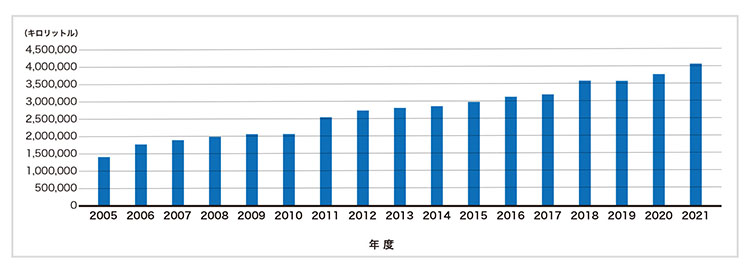
(Source: Japan Mineral Water Association statistical data)
Aummary
■ The “drinkability” and “mineral sensation” of mineral water. The taste varies depending on the “water source” from which it is collected.
■ Rich water sources, soil, and climate cultivate delicious rice. When choosing rice, pay attention not only to the brand but also to the “place of origin.”
■ The flavor and color of tea change depending on the water. If you want to feel the tea leaves more, use “soft water”; for a refreshing taste, use “hard water.”
■ Dashi, essential for winter hot pot dishes. Use “soft water” for a rich umami flavor, and “hard water” when you want to add a punch.
Taste analysis of mineral water from each manufacturer
Even among domestically produced waters from each manufacturer, the taste varies depending on the “water source.” The center of balance is “Suntory Natural Water,” while if you want to firmly feel the taste of water, try the mineral water from “ITO EN evian” for taste analysis.
[Figure 3] shows the balance between “drinkability” and “mineral sensation” of mineral water. The zero point represents the average of 39 types of mineral water.
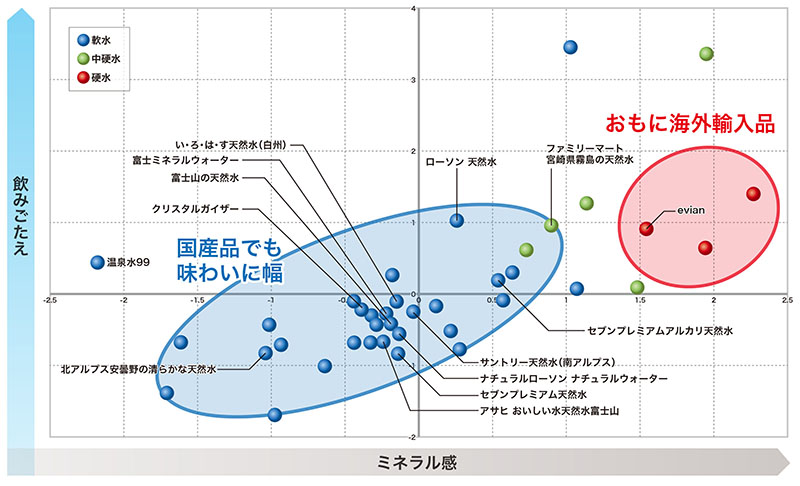
The balance between drinkability and mineral sensation tends to be milder when positioned in the lower left corner, gradually transitioning to the upper right corner as water hardness increases from medium to hard. This correlation is linked to the amount of calcium and magnesium contained in mineral water, with a significant influence from the location where the water is nurtured and harvested, known as the “water source.” For example, products mainly imported from Europe are positioned in the upper right corner. A stronger mineral sensation leads to a lingering aftertaste, and when both drinkability and mineral sensation are strong, the taste of water is firmly discernible.
The key point of this analysis is the variation in drinkability and mineral sensation even among domestically produced mineral waters. For example, “FamilyMart’s Natural Water from Kirishima, Miyazaki Prefecture” is a domestically produced product positioned in the upper right corner. Additionally, products labeled “Fuji” or “Mt. Fuji” are often located close to each other, suggesting similar flavors. From these observations, it can be inferred that the taste of water is significantly influenced by its place of origin, or the so-called “water source,” and the analysis results suggest a wide range of flavors.
Near the center of the graph, “Suntory Natural Water” (from the Southern Alps) is positioned, indicating a well-balanced product in terms of overall taste. We analyze various food products, and in every category, long-selling products tend to be positioned near the center of the graph. Such products can be said to have a taste that is easily supported by a wide range of people. On the other hand, products like “ITO EN evian” tend to have a strong drinkability and mineral sensation, suggesting a more distinct taste of water compared to domestically produced mineral water.
Does the difference in water sources affect the taste of products? Taste analysis of “Koshihikari” rice from across the country.
It is presumed that the taste of rice is largely influenced by the “water source × soil × climate” = place of origin.
While it has been suggested that the taste of water is greatly influenced by its water source, one might wonder if this also affects the flavors of products such as sake and rice that are nurtured by these water sources. Based on our taste database for “Koshihikari” rice, we verified the flavor balance of six types of Koshihikari rice.
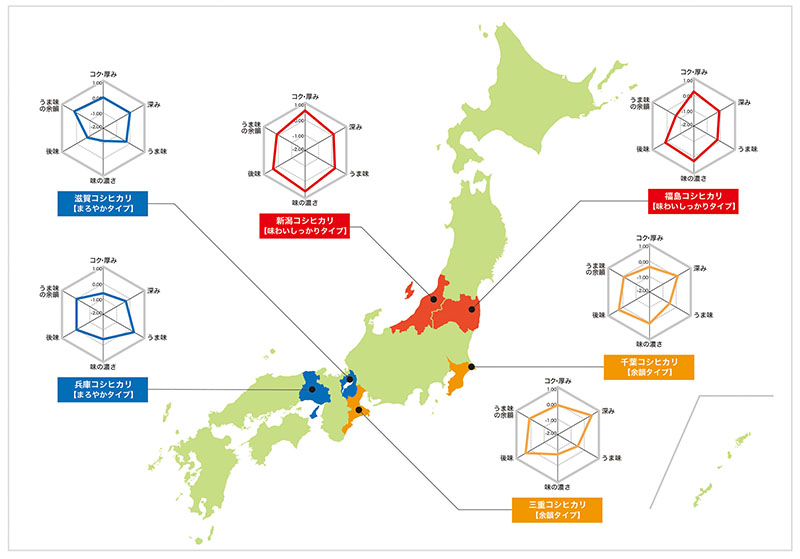
The analyzed Koshihikari rice can be broadly classified into three taste types, with rough regional characteristics identified. The red graph represents a robust flavor type. It is characterized by “richness/thickness,” “intensity of flavor,” and “aftertaste,” with a well-balanced overall graph indicating a taste that strongly expresses the essence of rice. This type of rice is often ranked high, such as the Special A Rank by the Japan Grain Inspection Association. The yellow graph represents a lingering type, with a strong “depth” and “aftertaste,” creating a lingering flavor experience. The blue graph represents a mellow type, characterized by “umami” and a lingering aftertaste.
Although attention tends to focus on the brand, even within the same brand, the taste varies, and this variation is broadly classified by region. There isn’t a single factor that determines the taste of rice, but factors such as water source, soil, and climate have a significant impact, and these factors are believed to manifest as regional characteristics.
There are also significant differences in appearance. Taste analysis of tea by changing the water.
“Tea leaf” sensation is stronger with soft water, while a refreshing taste is associated with hard water.
Next, without changing the tea leaves or brewing method, we examined how the taste and appearance of tea differ when only the water is changed. Focusing on the differences in mineral sensation, we selected five representative products of soft water, medium-hard water, and hard water for verification.
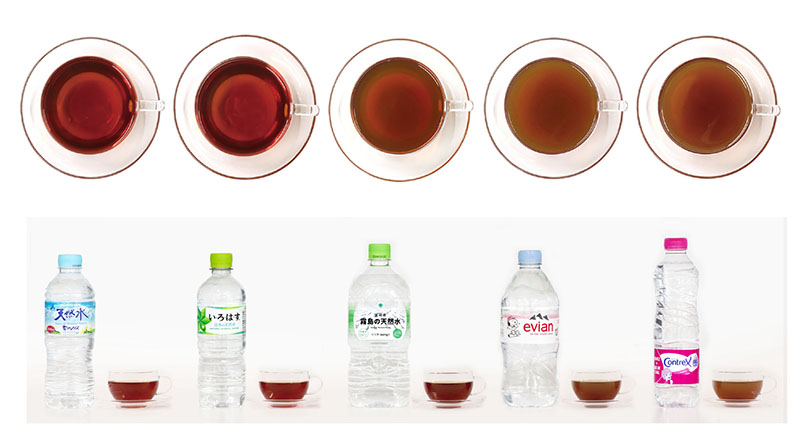
From left to right: Suntory Natural Water, Coca-Cola ILOHAS Natural Water, FamilyMart’s Natural Water from Kirishima, Miyazaki Prefecture, ITO EN evian, Contrex (bottom photo)

Soft water “Suntory Natural Water” (Southern Alps) and “Coca-Cola ILOHAS Natural Water” (Hakushu) are characterized by a strong tea leaf sensation, including bitterness and astringency, with a clear and vivid color. The medium-hard water “FamilyMart’s Natural Water from Kirishima, Miyazaki Prefecture” has a strong astringency, and the extracted liquid was slightly cloudy. The two hard waters differ in taste depending on the degree of hardness. “ITO EN evian” has a slightly miscellaneous taste, while “Contrex” has a refreshing taste with little bitterness and astringency and a slight acidity. Both of these were strongly cloudy, to the point where the bottom of the cup was not visible. The difference in water also affects the extraction power, and it is presumed that these differences are reflected in the taste and color.
When you want to take a light breather, try brewing with hard water and mix with milk to reduce bitterness. On the other hand, when you want to wake up refreshed, brew with soft water to enhance the tea leaf sensation. Understanding the characteristics of water will further expand the enjoyment of black tea.
Verify the compatibility of “dashi” with water, essential for winter hot pot dishes.
Soft water enhances richness and umami, while hard water adds punch when desired.
The essential dashi for winter hot pot dishes. Is there an ideal water to bring out the best in each dashi? We prepared dashi using kombu, bonito flakes, and dried sardines, and verified the taste of dashi due to differences in water.
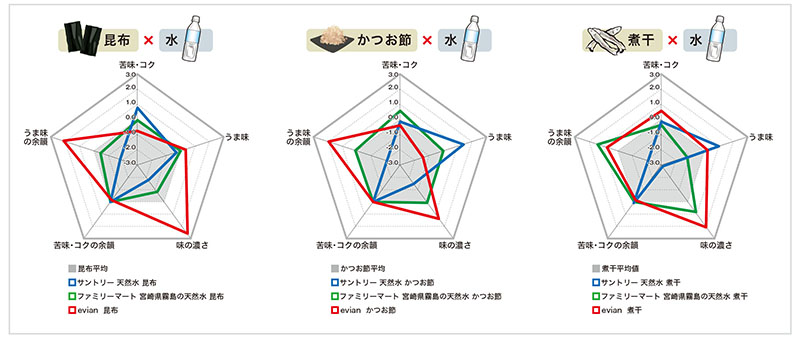
Regardless of the type of dashi, soft water generally produced a mild taste with enhanced richness and umami. Medium-hard water resulted in a well-balanced flavor, while hard water intensified the richness, intensity of flavor, and lingering umami, overall expanding the flavor profile. Additionally, similar to black tea, the clarity of the dashi decreased as the water hardness increased.
“Recommended Combinations of Water and Hot Pot Considering Compatibility with Dashi”

Soft water does not cloud the dashi and can bring out the richness and umami, making it suitable for dishes where color is important and you want to enjoy the flavor of the ingredients, such as o-zoni (Japanese New Year soup) and shabu-shabu.
Medium-hard water can extract the flavor of dashi evenly, making it suitable for hot pot dishes like “yosenabe” (assorted hot pot) and “chanko-nabe” (sumo wrestler’s hot pot), which contain a variety of ingredients.
Hard water can strongly extract the flavor of dashi, but tends to cloud the dashi. It is suitable for hot pot dishes like kimchi nabe and soy milk nabe, where the color of the dashi is not a major concern and you can enjoy the strong dashi flavor without being overpowered by seasonings.
This verification suggests that the compatibility between water and dashi is a factor in determining the flavor of hot pot dishes. By understanding the compatibility and characteristics of water and dashi, you can enjoy the upcoming hot pot season more deliciously and without getting tired of it.
Summary
Water (mineral water), which is often taken for granted in daily life and rarely consciously considered, has been found to have unique flavors. In addition to the examples mentioned above, soft water can be used in mild-flavored dishes such as dashi and soups to enhance the natural flavors of the ingredients. On the other hand, relatively strong-tasting mineral water could provide a unique flavor to alcoholic drinks when used as a mixer. By understanding the types and diversity of water, one can choose water not only based on price and functionality but also considering its impact on cooking and individual preferences. Additionally, paying attention to the origin of water, similar to rice and vegetables, and knowing the source of the water, could become an important factor in choosing water in the future.
■Mineral water taste analysis sample
Iris Ohyama Fuji Mountain Natural Water
Asahi Soft Drinks Asahi Oishii Mizu Natural Water Fuji Mountain
ITO EN evian
S.O. Onsen Water 99
Otsuka Foods Crystal Geyser
Coca-Cola ILOHAS Natural Water (Hakushu)
Contrex
Suntory Natural Water (Southern Alps)
Sirius North Alps Azumino’s Pure Natural Water
Seven & i Holdings Seven Premium Alkaline Natural Water
Seven & i Holdings Seven Premium Natural Water
Natural Lawson Natural Water
FamilyMart Kirishima, Miyazaki Prefecture Natural Water
Fuji Mineral Water Fuji Mineral Water
Lawson Natural Water
■How to extract black tea
200 g of boiled mineral water was added to 3 g of tea leaves and left to stand for 3 minutes. After standing still, the tea leaves were filtered through a nonwoven cloth, and the filtrate at room temperature was measured.
■Extraction method of dashi
[Kombu] Add 500g of mineral water to 15g of kombu and let it stand for 30 minutes. Heat on medium heat with an IH stove, and just before it boils, remove from heat and filter. Measure the liquid after it has cooled to room temperature.
[Bonito flakes] Add 200g of boiling mineral water to 8g of bonito flakes, and heat on high heat with an IH stove for 1 minute, then let it stand for 3 minutes. After filtering, squeeze the bonito flakes and measure the liquid after adding enough water to make 200g.
[Dried sardines] Place 15g of dried sardines (heads and guts removed) and 500g of mineral water in a small pot, heat on high heat with an IH stove, and once it boils, reduce to medium heat and heat for 10 minutes. Add water to make up for the lost moisture from heating, then filter. Measure the liquid after it has cooled to room temperature.
About Taste and Aroma Strategy Research Institute
Taste & Aroma Strategic Research Institute, a company that studies the science of food, utilizes visualization technology for the “deliciousness” of taste, aroma, texture, etc. This technology allows for the objectification of sensory values that were previously perceived through relative evaluation, enabling them to be used as evaluation criteria and scales. Since its establishment, the institute has continued to digitize food, and has built a taste database of over 120,000 food items. Based on this database, they provide food digital solution services that utilize data for various challenges related to food, such as food development, quality management, market research, and customization of taste for overseas markets.
Contact information
Email press@epochseed.jp
